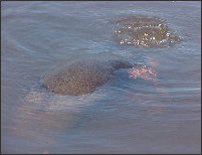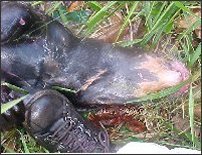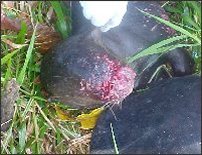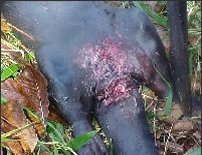 |
Last Update:
Thursday November 22, 2018
|
| [Home] |
|
Volume 20 Issue 2 Pages 58 - 90 (October 2003) Citation: Weber Rosas, F.C. and De Mattos, G.E. (2003) Natural Deaths Of Giant Otters (Pteronura Brasiliensis) In Balbina Hydroelectric Lake, Amazonas, Brazil . IUCN Otter Spec. Group Bull. 20(2): 62 - 64 Natural Deaths Of Giant Otters (Pteronura Brasiliensis) In Balbina Hydroelectric Lake, Amazonas, Brazil Fernando César Weber Rosas, Gália Ely De Mattos Instituto Nacional de Pesquisas da Amazônia (INPA), Laboratório de Mamíferos Aquáticos, Caixa Postal 478, Manaus - AM, 69011-970, Brazil. E-mail: frosas@inpa.gov.br (received 29th September 2003, accepted 17th November 2003)
In 1987 the Brazilian Northern Electric Company (ELETRONORTE) finished damming the Uatumã River that formed the 3,246 km2 lake (containing 3,299 islands) of the Balbina hydroelectric power station. In 2001, through a project entitled "Social organization, behavior and diet of the giant otter (Pteronura brasiliensis) in the influenced area of Balbina hydroelectric power station, Amazonas, Brazil", the authors started to study giant otters in the reservoir (de MATTOS et al., 2002; ZUANON et al., 2002). Despite being an enormous area, we managed to record two dead otters in the lake. One of them was found in February 2002 at the entrance of one of the giant otters' dens (01°35'21.3"S; 59°40'15.6"W). Judging from the general condition of the carcass, the animal, a 150 cm long female weighing 11 kg, had died about 2 days before it was found. This individual didn't have any visible injury on its body and the fur, which was intact, fell off when handled. The internal organs were emaciated and most of them in an advanced stage of decomposition due to the high temperature, characteristic of this tropical region. Based on the total length, it seemed to be a young adult female, which probably died a natural death. The low weight of this otter (only 11 kg) seems to corroborate this hypothesis. According to our data of captive giant otters in Amazonia, a 150 cm animal should weigh on average 19.0 ± 2.9 kg (n = 4) (F. Rosas, pers. obs.). The second dead giant otter was recorded in July 2003. This animal was found and reported to us by the rangers of the Uatumã Biological Reserve (ReBio Uatumã/IBAMA). According to the rangers, a moribund otter was found in the water at 9:50 a.m., surrounded by a group of 6-8 other giant otters. The animal was still breathing when it was found. The rangers removed it from the water and pulled it to the margin. At that moment, they could observe that it had been seriously wounded (Fig. 1).
The otter died at 10:25 a.m. and the rangers threw the body back into the water. Three weeks later, during our next field trip to Balbina Lake, we tried to recover the carcass but it wasn't found. It is interesting to note that this otter had been severely bitten on its snout and genital areas (Fig. 1c and 1d). Our data on captive giant otters have already revealed that the genital area is one of the regions of the body where animals tend to concentrate their attacks while fighting. Other severe wounds were observed near the forelimbs. According to the rangers, even though the animal was bleeding, there were no "piranhas" around it. A careful examination of the wounds shown in the pictures suggests that other giant otters had attacked the animal. This is supported by the presence of other otters around it, which, despite not fighting at the moment the rangers arrived, could be the ones responsible for the deadly wounds caused to the animal. This opinion is also shared by Dr. Duplaix, who has reported terrible fights among giant otters both in captivity and in the wild in Guyana (N. Duplaix, pers. comm.). The area where the moribund giant otter was found is very interesting since it seems to represent an overlap in the territory of at least two giant otter groups. During our observations, we managed to see different groups passing or fishing in that specific area, however, we never recorded the encounter of any groups. Although we cannot confirm that the giant otter died due to a fight with other otters, all the evidence points in this direction. Antagonistic behavior among giant otters has already been documented in the literature. According to SCHWEIZER (1992) an encounter of two different groups resulted in serious injuries to one adult otter and the death of a giant otter calf. MOURÃO and CARVALHO (2001) recorded an adult male giant otter killing and eating (cannibalism) a young cub from a different group in the Brazilian Pantanal. The apparently "natural deaths" of giant otters reported here may have a significant role in the dynamics of the species. Even though Balbina is an artificial lake, it doesn't seem to have any spatial or feeding limitation (F. Rosas, pers. obs.), factors that usually lead to a high rate of natural mortality in a species. Despite the lake's huge size, which makes it harder to find carcasses, we have recorded in a two-year period two dead animals that seemed to have died natural deaths. These data suggest that natural mortality may have an important role in the biology of giant otters in Balbina Lake and should be taken into account in future management plans for the species. Acknowledgements - We thank Centro de Preservação e Pesquisa de Mamíferos Aquáticos (CPPMA)/ Manaus Energia S.A. and ReBio Uatumã/IBAMA, who provided logistical support in the field. We also thank Kesä K. Lehti and two anonymous reviewers for valuable comments and the English review made on earlier drafts of this manuscript. We are grateful to Fundação O Boticário de Proteção à Natureza (project nº 053220021) for the financial support given to our study. References MATTOS, G.E. de; ROSAS, F.C.W., PICANÇO,
M.C.L. & LAZZARINI, S.M. (2002). Utilização do lago da Hidrelétrica de
Balbina (Amazonas, Brasil) por Pteronura brasiliensis. In: Abstracts X
Reunión de Trabajo de Especialistas en Mamíferos Acuáticos de
América del Sur. Valdivia, Chile, pp. 74-75. |
|||||||
| [Copyright © 2006 - 2050 IUCN/SSC OSG] | [Home] | [Contact Us] |



